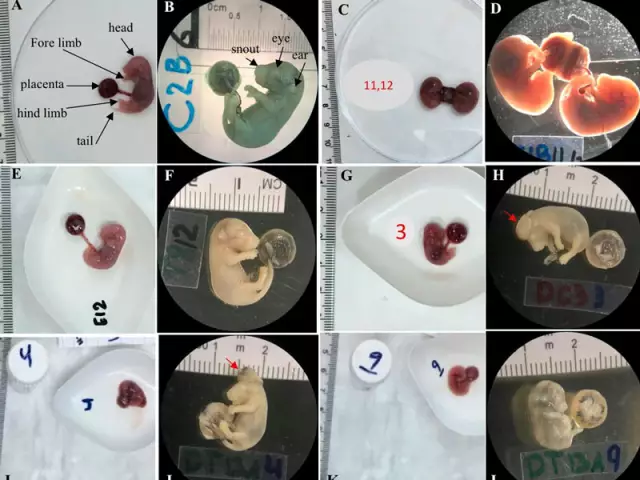- Author Rachel Wainwright [email protected].
- Public 2023-12-15 07:39.
- Last modified 2025-11-02 20:14.
Congenital malformations

Congenital malformations of the fetus are one of the most serious complications of pregnancy, leading to infant mortality and disability. The birth of a child with congenital malformations is often the cause of family breakdown. Not all parents can survive such a shock and begin to blame each other for what happened.
Medical statistics show that in recent decades, the number of children with congenital malformations has been growing steadily throughout the world. In Russia, the frequency of this pathology is 5-6 cases per thousand births, in Western Europe this figure is about half as low.
Causes of congenital malformations
Various reasons can lead to the formation of congenital malformations in the fetus. Most often, this pathology occurs as a result of genetic mutations caused by the use of alcohol, drugs, exposure to ionizing radiation and other harmful factors. Congenital malformations can also be caused by various abnormalities in the chromosome sets of the father or mother, as well as a lack of vitamins, especially folic acid, in the diet of a pregnant woman.
Classification of congenital malformations
There are various criteria on the basis of which doctors build a classification system for congenital malformations. Depending on the cause, congenital malformations of the fetus are divided into environmental (exogenous), hereditary (endogenous) and multifactorial.
The development of hereditary malformations is due to a change in chromosomes or genes in gametes, which is the cause of chromosomal, gene or genomic mutations in the zygote (fertilized egg). These mutations lead to disturbances in the formation of tissues and organs in the fetus.
Exogenous congenital malformations occur under the influence of various teratogenic factors (industrial poisons, smoking, alcohol, viruses, drugs, and much more).
Multifactorial congenital malformations of the fetus are such defects, the development of which is due to the joint influence of genetic and environmental factors.
Depending on at what stage of embryogenesis (fetal formation) exogenous or genetic factors begin to show their effect, developmental defects are divided into the following types:
- Gametopathy or blastopathy. Developmental disorders appear already at the zygote or blastula stage. They are very rude. Most often, the embryo dies and it is rejected - a spontaneous abortion. In cases where miscarriage does not occur, a non-developing (frozen) pregnancy occurs.
- Embryopathy. Development defects occur between 15 days and 8 weeks of embryo life. Embryopathies are the most common cause of fetal birth defects.
- Fetopathy. It occurs under the influence of adverse factors after 10 weeks of pregnancy. In this case, congenital malformations are usually not of a gross nature and are manifested by the appearance of various functional disorders in the child, delayed mental and physical development, and a decrease in body weight.
In addition, primary and secondary congenital malformations of the fetus are distinguished. Primary ones are always caused by the direct influence of any teratogenic factors. Secondary malformations arise as a complication of primary ones, and are always associated with them pathogenetically.

The World Health Organization has proposed a classification of congenital malformations according to the place of their localization, i.e. based on the anatomical and physiological principle. In accordance with this classification, there are:
- Congenital malformations of the nervous system. These include spina bifida (open spinal hernia), underdevelopment of the brain (hypoplasia) or its complete absence (anencephaly). Congenital malformations of the nervous system are very serious and most often lead to the death of a child in the first hours of his life or the formation of permanent disability.
- Deformities of the maxillofacial region - cleft palate, cleft lip, underdevelopment of the lower or upper jaw.
- Congenital malformations of the limbs - their complete absence (atresia) or shortening (hypoplasia).
- Congenital malformations of the cardiovascular system. These include malformations of the heart and large blood vessels.
- Other congenital malformations.
How to prevent the birth of a child with congenital malformations?
Pregnancy planning should be very responsible. The high risk group for having a sick child includes:
- Families in which there have already been cases of the birth of children with various congenital malformations;
- Families in which previous pregnancies ended in intrauterine fetal death, spontaneous miscarriage or stillbirth;
- Spouses in a family relationship (cousins, second cousins and brothers);
- If a man is over 50 years old and a woman is 35 years old;
- If a man or woman is exposed to the adverse factors listed above due to the state of his health or professional activity.
If you belong to a high-risk group for having a child with developmental defects, then before actively planning a pregnancy, you should definitely visit a geneticist. The specialist will draw up a pedigree and calculate the risk of having a sick child. At a very high risk, a married couple is usually recommended to resort to artificial fertilization of the donor egg or insemination with the donor's sperm.
Are you already expecting a baby and are you in a high-risk group? And in this case, you should definitely consult with a geneticist. Never make an independent decision to terminate a pregnancy in cases where you did not know about it and were taking certain medications, had fluorography or, for example, drank alcohol. How much, in fact, in such situations there is a high risk of congenital malformations in the fetus, only a doctor can decide after conducting the necessary research.
What if your baby has a congenital malformation?
Any married couple who have a sick child, and especially with congenital malformations of the nervous system, experiences a state of psychological shock. In order to cope with it, contact a geneticist and find out the exact cause that led to the development of pathology. A sick child should definitely undergo a cytological examination. This is necessary not only for its treatment, but also for predicting the likelihood of re-birth in these spouses of a sick baby.
The final medical genetic consultation should be carried out no earlier than three months after delivery. During this time, the psychological tension in the family usually decreases, and the spouses will be able to adequately perceive all the information they need.
YouTube video related to the article:
The information is generalized and provided for informational purposes only. At the first sign of illness, see your doctor. Self-medication is hazardous to health!






